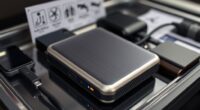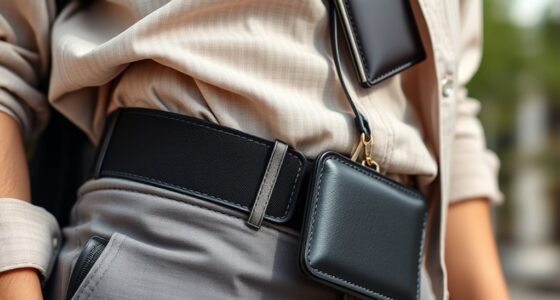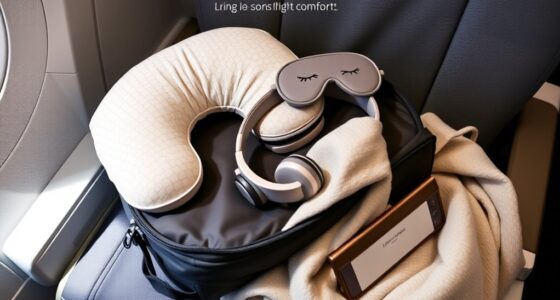If you’re choosing between noise-canceling headphones and earplugs for flights, consider how much noise reduction you need and your comfort. Headphones actively block cabin noise and improve sound quality, making long flights more enjoyable, but they’re bulkier and pricier. Earplugs are affordable, portable, and fit easily, providing passive noise reduction for quick relief. Your ideal choice depends on your flight duration, noise levels, and preferences—discover more to make the best decision for your trip.
Key Takeaways
- Noise-canceling headphones provide superior active noise reduction and audio quality, especially in loud environments like flights.
- Earplugs are more portable, affordable, and discreet, making them ideal for quick relief and short-term use.
- Headphones offer better comfort for extended wear and include features like customizable sound profiles.
- Earplugs are lightweight, conform to the ear canal, and are less bulky, suitable for turbulent or moderate noise levels.
- The choice depends on flight duration, noise intensity, comfort preference, and budget considerations.
Effectiveness in Reducing Cabin Noise

When it comes to reducing cabin noise during a flight, noise-canceling headphones generally outperform earplugs. They actively block out sound with advanced noise-canceling technology, making it easier to enjoy your music or rest. The sound quality of these headphones is also superior, providing clearer audio and richer bass, which enhances your overall experience. Battery life is essential because noise-canceling features drain power; many models offer several hours of active noise cancellation on a single charge, ensuring you stay protected throughout your flight. Earplugs, on the other hand, provide passive noise reduction but do not improve sound quality or offer the same level of noise control. Overall, if effective noise reduction is your priority, headphones with good battery life and sound quality are the better choice. Contrast ratio plays a role in how well audio and ambient sounds are perceived, which can influence overall listening comfort during flights. Additionally, understanding aircraft cabin acoustics can help you choose the most effective noise-canceling solution for your needs. Recognizing how technology integration enhances noise-canceling features is also beneficial in making an informed decision. Considering personal comfort is also important, as some travelers find headphones more comfortable for long durations compared to earplugs. Properly selecting an appropriate audio device can significantly improve your in-flight experience by balancing comfort and noise reduction.
Comfort and Fit During Flights

Comfort and fit are crucial factors to take into account when choosing between noise-canceling headphones and earplugs for flights. In-flight comfort depends heavily on how well each option fits your ears or head. Noise-canceling headphones provide a snug fit around your ears, often offering cushioning that enhances overall comfort during long flights. Earplug ergonomics, on the other hand, focus on how easily they conform to your ear canal and stay in place without causing discomfort. If you prefer lightweight, minimal contact, earplugs might be more comfortable. However, some find headphones more comfortable because they distribute pressure evenly around the head. Ultimately, your choice hinges on personal preference for fit and how each option feels during extended periods in the air.
Portability and Convenience

Portability and convenience are key considerations when choosing between noise-canceling headphones and earplugs for flights. Noise-canceling headphones typically have a longer battery life, allowing you to enjoy extended use without frequent recharges, but they can be bulkier and require a carrying case for ease of storage. Earplugs, on the other hand, are small, lightweight, and easily stored in a pocket or bag, making them highly portable. They require no power, so you don’t worry about battery life. If convenience is your priority, earplugs are simple to carry and use on the go. Additionally, sound vibrations from noise-canceling headphones can influence brainwave patterns, potentially enhancing relaxation during flights. However, if you prefer active noise cancellation and don’t mind managing chargers and storage, headphones offer a more versatile option. Consider your travel habits when choosing the most convenient solution. Additionally, noise-canceling headphones often come with various features such as touch controls and customizable sound profiles that can enhance your travel experience. Furthermore, some airplane cabin noise can interfere with the effectiveness of either option, so choosing the right solution depends on your specific environment and preferences. Moreover, antioxidants found in certain foods and drinks can help mitigate some of the adverse effects of noise exposure by supporting overall health. Properly understanding noise reduction techniques can also help optimize your in-flight experience.
Cost and Accessibility

Cost and accessibility play significant roles in deciding between noise-canceling headphones and earplugs for flights. A quick price comparison shows that earplugs are usually very affordable, often costing just a few dollars, and are widely available worldwide at drugstores and airports. In contrast, noise-canceling headphones tend to be more expensive, ranging from moderate to high prices depending on the brand and features, but they are also accessible online and in stores globally. If you’re on a tight budget or need a quick solution, earplugs offer an economical choice. However, if you want better sound quality and longer-term use, investing in noise-canceling headphones can be worthwhile. Both options are generally easy to find, but your budget and access will influence your decision most. Additionally, floating on water can be a relaxing way to recover from a long flight or enjoy some downtime after your journey.
Suitability for Different Flight Conditions

Different flight conditions can considerably influence whether noise-canceling headphones or earplugs are more effective. If the noise level is high, such as during takeoff and landing, noise-canceling headphones can better reduce engine sounds and chatter, especially on long flights. They also offer comfort over extended periods, making them suitable for long-duration flights. Additionally, noise-canceling technology enhances the effectiveness of headphones in noisy environments, ensuring a more peaceful experience. Conversely, if the noise level is moderate or you need quick relief, earplugs provide a simple, lightweight option that can be easily inserted and removed. Earplugs also have the advantage of being more discreet and less bulky than headphones. In noisy cabins or during turbulent conditions, earplugs help block out background noise without the bulk of headphones. Your choice depends on the noise intensity and flight length, ensuring you optimize comfort and noise reduction based on specific flight conditions. Considering the noise-canceling technology and its effectiveness can help you make the best choice for your flight. Additionally, understanding the environmental noise levels can guide you in selecting the most suitable hearing protection. Recognizing the weight of wind turbine blades and their design features underscores the importance of comfort and usability in noise reduction devices, especially during long journeys. Moreover, evaluating the comfort and fit of each option can significantly impact your overall experience during the flight.
Frequently Asked Questions
Are Noise-Canceling Headphones Safe to Use During Takeoff and Landing?
Yes, noise-canceling headphones are generally safe during takeoff and landing if you follow safety considerations and usage guidelines. Make sure to keep the headphones at a comfortable volume to stay aware of announcements and potential emergencies. It’s best to remove or lower the volume during critical moments, like takeoff and landing, to ensure you can hear safety instructions. Always follow airline rules and manufacturer recommendations for safe use.
Can Earplugs Cause Ear Infections With Prolonged Use on Flights?
Earplugs can be a double-edged sword, like a sharp knife. Prolonged use on flights might increase ear infection risks if you don’t keep them clean or if moisture gets trapped. Concerns about ear infections stem from bacteria build-up or pressure imbalances. To reduce risks, clean your earplugs regularly, avoid sharing them, and limit continuous use. Proper hygiene helps protect your ears on long flights.
How Do Noise-Canceling Headphones Affect In-Flight Entertainment Audio Quality?
Noise-canceling headphones can enhance your in-flight entertainment by improving audio clarity, making dialogue and music more distinct. However, their active noise-canceling feature may slightly impact battery life, so you’ll want to make sure they’re fully charged before your flight. Using these headphones, you’ll enjoy clearer sound, but keep an eye on the battery to avoid interruptions, especially during long flights.
Are There Allergy Concerns Related to Certain Earplug Materials?
Imagine your ears as delicate gardens; allergenic materials in earplugs can be like invasive weeds. If you’re sensitive to latex allergies, be cautious, since some earplugs contain latex, which can trigger reactions. Always check labels for allergenic materials, and opt for hypoallergenic or silicone options if you’re prone to allergies. Protect your peace and health by choosing earplugs that respect your body’s unique needs.
Do Noise-Canceling Headphones Interfere With Aircraft Communication Systems?
Noise-canceling headphones generally do not interfere with aircraft communication systems. They are designed to minimize electromagnetic interference that could cause communication disruptions, so you shouldn’t worry about losing contact with flight crew. However, it’s always best to follow airline instructions and keep the headphones in a mode that doesn’t block essential signals during critical phases of the flight. This way, you stay comfortable without risking communication issues.
Conclusion
Choosing between noise-canceling headphones and earplugs depends on your flight needs. As you settle into your seat, imagine slipping on sleek headphones that block the roar of engines, or gently inserting earplugs, like whispering quiet into your ears. Both can transform your journey, turning a noisy cabin into a peaceful retreat. Whether you prefer tech or simplicity, the right choice lets you find calm amidst the clouds, making every flight feel like a quiet escape.









